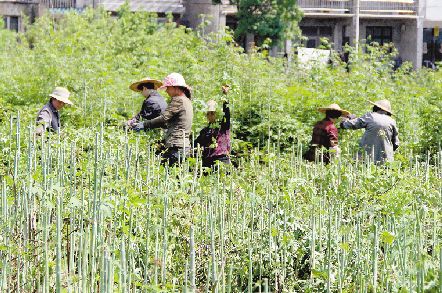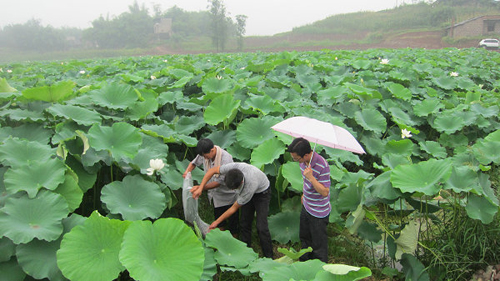The cultivation of traditional Chinese medicine depends on the market.

At the planting base of Peng Fugui, a medicinal plant grower in Chengnan town, more than a dozen workers "got stuck" in the bushes, cut off the branches of raspberries and picked the raspberries that grew on them. These raspberries are different from what we usually eat. Except for a few that are a little red, they are basically green. "the red raspberry means it is ripe and can be eaten as fruit. However, these are used as medicinal materials, that is, they need cyan and are not yet mature. " Peng Fugui said.
Artificially planted raspberries can be sold for 90 yuan per jin.
Peng Fugui began to grow traditional Chinese medicine five or six years ago. "Atractylodes macrocephala Koidz was planted before, but this variety is more popular and the benefit is not very good, so raspberries and irises were planted the year before last." Peng Fugui says that this is the first year of raspberry harvest and the best price in the past few years. "after picking in early May, a catty can be sold for about 90 yuan. On the market, the price of a jin of dried raspberries was 58 yuan to 70 yuan the year before last and 65 yuan to 75 yuan last year. "
Because fresh raspberries are difficult to keep, Peng Fugui specially bought a dryer to dry or dry raspberries. "at the beginning of picking, raspberries were relatively tender. It took about 3.5 jin to 4 jin to dry into 1 jin of dried fruit. Now 3 jin can turn into 1 jin of dried fruit." Peng Fugui estimates that 100 jin of raspberry nuts can be harvested per mu of land this year. "it's mainly because it rained for a long time during flowering, which affected the yield. I estimate that 200 jin to 300 jin of dried fruit can be harvested per mu next year."
Peng Fugui is not worried about the sale of raspberries. "now there are not many people who grow raspberries, and the quality of wild raspberries is not good. The price of artificial cultivation is getting higher and higher, and the market is very good. The medicine company will take the initiative to buy it."
In addition to raspberries, Peng Fugui's irises will also have a bumper harvest in August. "the market price of irises is not low this year, with prices ranging from 14.5 yuan to 15 yuan per jin, compared with 7.5 yuan per jin the year before last."
More than 600 mu of traditional Chinese medicine have been planted in the south of the city, and you can still get a subsidy if you plant more.
It is not only Peng Fugui who is growing traditional Chinese medicine. In the past two years, many growers in the south of the city have begun to set foot in the market of traditional Chinese medicine. "up to now, our Chengnan Town has planted more than 600 mu of Chinese herbal medicines, the main varieties of which are raspberries, lilies, clover green and so on. Peng Fugui planted 60 mu of raspberries and 60 mu of irises. " The relevant person in charge of Chengnan town said.
In order to encourage people to plant traditional Chinese medicine and flowers on a large scale, Chengnan Town also introduced a relevant subsidy policy last year, giving subsidies ranging from 600 yuan to 1000 yuan per mu for three consecutive years. For example, if the ornamental traditional Chinese medicine is planted in pieces of 20 mu or more, and the land lease is 3 years or more, the subsidy will be 1000 yuan per mu in the first year, 600 yuan per mu in the second year, and 1000 yuan per mu in the third year. The same is true of economic traditional Chinese medicine planted in pieces, with a subsidy of 600 yuan per mu in the first year, 400 yuan per mu in the second year, and 200 yuan per mu in the third year.
The products planted by Peng Fugui this time involve two subsidies: ornamental Chinese herbal medicines and economical Chinese herbal medicines. "I was the first to apply, and I have already received a subsidy of more than 80,000 yuan in the first year." Peng Fugui said.
The cultivation of traditional Chinese medicine should not be too blind. Dendrobium candidum is a counterexample.
According to the preliminary statistics of the Municipal Agriculture and Forestry Bureau, the planting area of Wenling traditional Chinese medicine has been thousands of mu, of which the most is Dendrobium candidum.
"the traditional Chinese medicine in our city is mainly Dendrobium candidum, which is mainly distributed in Daxi, Wencheng, Chengnan, Ruoheng and other places. according to incomplete statistics, the area of Dendrobium candidum in the city has more than 800 mu, and it is mainly cultivated in facilities. In addition to Dendrobium candidum, saffron, clover, raspberry and foxglove have also been planted repeatedly in the past two years. " The relevant staff of the Municipal Agriculture and Forestry Bureau said. However, because many growers do not do enough market research, leading to difficulties in sales and prices, for example, the price of Dendrobium candidum has dropped a lot in recent years. In the past, Dendrobium candidum, which used to cost thousands of yuan per kilogram, can now be bought for less than 100 yuan.
Some growers said that in 2013, Dendrobium candidum could sell for 500 to 600 yuan a jin, but in 2014, it fell to 200 to 300 yuan, and it was difficult to sell even one or two hundred yuan in the past two years.
"before planting traditional Chinese medicine, we still need to know more about the market environment, not blindly. For example, growing raspberries in the south of the city is actually a good choice. On the one hand, it is not difficult to grow raspberries, on the other hand, there is market demand, and wild raspberries cannot grow in pieces, which provides opportunities for artificial cultivation of raspberries. " The staff member said.
"many Chinese herbs are suitable for growing under the forest, the quality will be better, and can make rational use of woodland, not only cheap rent, but also do not need to build too much infrastructure, can save a lot of cost. However, although the quality of planting under the forest will be better, because it is imitating wild planting, the yield may be affected. "
Related
- A course of planting techniques and methods on how to grow carrots
- How to plant the latest tulips?
- Is it better to pick tea in the morning or in the afternoon? When is the best time for tea to be picked? what is the third or fifth tea?
- Launch Yuanxiao Happy combination Haocha + Tea Yuan healthy Taste
- Penghu Tourism "Fireworks 20 Parade with You"
- 2022 West Lake Happiness holds "Digital Revitalization Voucher" and draws iphone13 and laptop.
- Banqiao Fuzhou social houses are designed to change start-up combined with police elimination to create a safe and livable environment
- The convenient measure of "mechanical weeding" in Xinbei has been abused and the Agriculture Bureau has imposed heavy penalties on the illegal land consolidation.
- Changgeng University Joins Hands with Four Memory Factories to Rescue Memory Talent Shortage
- The list of Taiwan's top 100 MVP managers is listed by the Director-General of the Farmers' Association of Sanxia District.



